Related Research Articles

Easy Jet (1967–1992) was a racing champion American Quarter Horse. He was one of only two horses to have been a member of the American Quarter Horse Association (AQHA) Hall of Fame as well as being an offspring of members. Easy Jet won the 1969 All American Futurity, the highest race for Quarter Horse racehorses, and was named World Champion Quarter Race Horse in the same year. He earned the highest speed rating awarded at the time—AAAT. After winning 27 of his 38 races in two years of racing, he retired from the race track and became a breeding stallion.

Go Man Go (1953–1983) was an American Quarter Horse stallion and race horse. He was named World Champion Quarter Running Horse three times in a row, one of only two horses to achieve that distinction. Go Man Go was considered to be of difficult temperament. While waiting in the starting gate for his first race, he threw his jockey, broke down the gate, and ran alone around the track; he was eventually caught and went on to win the race. During his five years of competition until he retired from racing in 1960 he had 27 wins, earning more than $86,000.
Joe Hancock (1926–1943) was an influential Quarter Horse sire in the early years of the American Quarter Horse Association.
Joe Reed II (1936–1964) was a Quarter Horse racehorse from the early days of the American Quarter Horse Association that became an influential sire with the breed.
Joe Reed (1921–1947), often known as Joe Reed P-3, was a Quarter Horse racehorse from the early days of the American Quarter Horse Association that became an influential sire with the breed.
Leo (1940–1967) was one of the most influential Quarter Horse sires in the early years of the American Quarter Horse Association.
Bert (1934—1956) was one of the most influential sires in the early years of the American Quarter Horse Association (AQHA). He was posthumously inducted into the AQHA Hall of Fame.
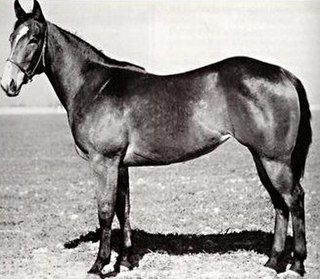
Chicado V was a Champion Quarter Horse racehorse foaled (born) in 1950, and considered one of the outstanding broodmares of her breed. She was bred by Frank Vessels of Los Alamitos, California, and trained by Earl Holmes.
A registered Thoroughbred mare, Lena's Bar (1954–1969) raced on the Quarter Horse racetracks and was the dam of Jet Smooth, Double Dancer and Easy Jet, three outstanding Quarter Horse stallions.
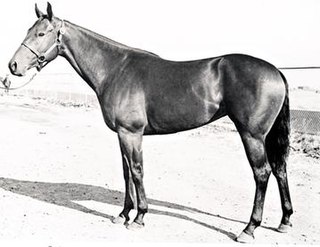
Barbara L (1947–1977) was an American Quarter Horse that raced during the early 1950s and often defeated some of the best racehorses of the time. She earned $32,836 on the race track in 81 starts and 21 wins, including six wins in stakes races. She set two track records during her racing career. After retiring from racing in 1955, she went on to become a broodmare and had 14 foals, including 11 who earned their Race Register of Merit with the American Quarter Horse Association (AQHA). Her offspring earned more than $200,000 in race money. She died in 1977 and was inducted into the AQHA's American Quarter Horse Hall of Fame in 2007.
An outstanding Quarter Horse racehorse, Charger Bar (1968–1997) was the 1971 World Champion Quarter Running Horse and an American Quarter Horse Association Superior Race Horse. She was posthumously inducted into the American Quarter Horse Hall of Fame.
Goetta was the World Champion Quarter Running Horse for 1964, and for a time led the list of all time money-earning Quarter Horse racehorses.
FL Lady Bug (1945–1974) was a Quarter Horse mare who was never raced or was shown in a horse show, yet was made famous for her speedy offspring.
A registered Thoroughbred, Cherry Lake raced mostly on the Quarter Horse racetracks and made her mark on the Quarter Horse breed as a broodmare. She was posthumously inducted into the American Quarter Horse Hall of Fame.
Shue Fly (1937–1963) was a Quarter Horse mare who was one of the dominant racehorses on the racetrack during the 1940s.
While successful at the Quarter Horse racetrack, Ought To Go was far more successful in the breeding shed, producing twelve foals. Ten of those foals started and won races.
Easy Date was an outstanding Quarter Horse racehorse and broodmare.
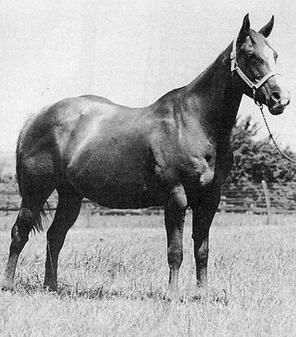
Garrett's Miss Pawhuska (1946–1975) was a Quarter Horse broodmare who produced eight foals, three of which would become world champion race horses. When she was a yearling, she was sold by her owner, although he had not really planned on selling her. He felt he had to because one of his employees had told a customer the filly was for sale.
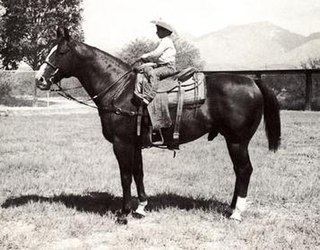
Lightning Bar (1951–1960) was an American Quarter Horse who raced and subsequently became a breeding stallion. He was bred by his lifelong owner Art Pollard of Sonoita, Arizona, and was the offspring of Three Bars, a Thoroughbred, and Della P, a Quarter Horse mare from Louisiana, then noted for the breeding of sprint horses. Lightning Bar raced ten times, achieving four victories and four other top-three finishes. His racing career was cut short by illness after only one year, following which he spent two years as a show horse. As a breeding stallion, he sired seven crops, or years, of foals, among whom Doc Bar was the best known. In 1960 Lightning Bar died of an intestinal infection at the age of nine. He was inducted into the American Quarter Horse Association's (AQHA) Hall of Fame in 2008.
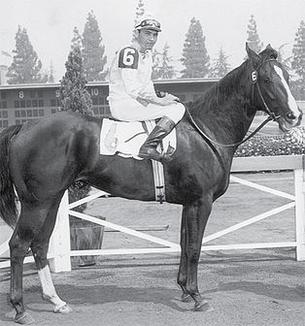
Miss Meyers was an American Quarter Horse racehorse and broodmare, the 1953 World Champion Quarter Running Horse. She won $28,725 as well as 17 races. As a broodmare, she produced, or was the mother of, the first American Quarter Horse Association (AQHA) Supreme Champion called Kid Meyers. She was the mother of three other foals, and was inducted into the AQHA Hall of Fame in 2009.
References
- American Quarter Horse Association (AQHA). "Black Easter Bunny". AQHA Hall of Fame. American Quarter Horse Association. Retrieved August 20, 2017.
- Nye, Nelson C. (1964). The Complete Book of the Quarter Horse: A Breeder's Guide and Turfman's Reference. New York: A. S. Barnes and Co.
- Nye, Nelson C. (1983). Great Moments in Quarter Racing History. New York: Arco Publishing. ISBN 0-668-05304-6.
- "Pedigree of Black Easter Bunny". All Breed Pedigree Database. AllBreedPedigrees.com. Retrieved July 1, 2007.
- Wagoner, Dan (1976). Quarter Racing Digest: 1940 to 1976. Grapevine, TX: Equine Research.